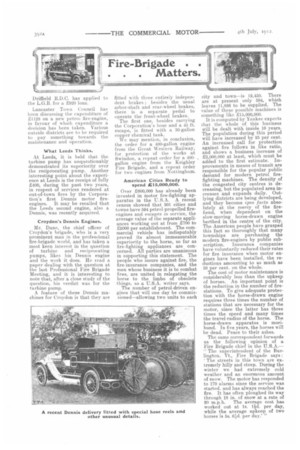Fire-Brigade Matters.
Page 14

If you've noticed an error in this article please click here to report it so we can fix it.
Driffield R.D.C. has applied to the L.G.B. for a 2920 loan.
Lancaster Town Council has been discussing the expenditure of 21128 on a new petrol fire-engine, in favour of which expenditure a decision has been taken. Various outside districts are to be required to pay something towards the maintenance and operation.
What Leeds Thinks,
At Leeds, it is held that the turbine pump has unquestionably demonstrated its superiority over the reciprocating pump. Another interesting point about the experience at Leeds is the receipt of fully 2400, during the past two years, in respect of services rendered at out-of-town fires by the Corporation's first Dennis motor fireengines. It may be recalled that the Leeds second engine, also a Dennis, was recently acquired.
Croydon's Dennis Engines.
Mr. Dane, the chief officer of Croydon's brigade, who is a very prominent man in the professional fire-brigade world, and has taken a most keen interest in the question of turbine and reciprocating pumps, likes his Dennis engine and the work it does. He read a paper dealing with the question at the last Professional Fire Brigade Meeting, and it is interesting to note that, after a close study of the question, his verdict was for the turbine pump.
A feature of these Dennis machines for Croydon is that they are fitted with three entirely independent brakes ; besides the usual arbor-shaft and rear-wheel brakes, there is a separate pedal to operate the front-wheel brakes.. The first one, besides carrying the Corporation's hose and a 45 ft. escape, is fitted with a 30-gallon copper chemical tank. e may mention, in conclusion, the order for a 400-gallon engine from the Great Western Railway, for protection of the works at Swindon, a repeat order for a 400gallon engine from the Keighley Fire Brigade, and a repeat order for two engines from Nottingham.
American Cities Ready to spend £15,000,000.
Over 2600,000 has already been invested in motor fire-fighting apparatus in the U.S.A. A recent census showed that 301 cities and towns have 594 petrol-propelled fireengines and escapes in service, the average value of the separate appliances working out at from 2700 to 22000 per establishment. The commercial vehicle has indisputably proved its almost immeasurable superiority to the horse, so far as fire-fighting appliances are concerned. All parties are unanimous in supporting this statement. The people who insure against fire, the fire-insurance companies, and the men whose business it is to combat fires, are united in relegating the horse to the limbo of obsolete things, so a U.S.A. writer says. . The number of petrol-driven engines that will one day be commissioned—allowing two units to each
city and town—is 12,450. There are at present only 594, which leaves 11,856 to be supplied: The value of these possible machines is something like 215,000,000. It is computed by Yankee experts that the whole of this business will be dealt with inside 10 years. The population during this period will have increased by 25 per cent. An increased call for protection against fire follows in like ratio, and shows a business increase of 23,000,000 at least, which must be added to the first estimate.. Improvements in means of transit are responsible for the popular public demand for modern petrol firefighting machines. The density of the congested city centres is decreasing, but the populated area increases and expands daily. Outlying districts are being developed, and they become ipso facto absolutely at the mercy of the firefiend, when dependent on the slow-moving horse-drawn engine berthed in the centre of the city. The American people have grasped this fact BO thoroughly that many townships are purchasing the modern fire-engines by public subscription. Insurance companies have voluntarily reduced their rates for fire insurance when motor engines have been installed, the reductions amounting to as much as 50 per cent. on the whole.
The cost of motor maintenance is considerably less than the upkeep of horses. An important point is the reduction in the number of firestations. To give adequate protection with the horse-drawn engine requires three times the number of stations that are necessary for the motor, since the latter has three times the speed and many times the travel-radius of the horse. The horse-drawn apparatus is moribund. In five years, the horses will be dead. Peace to their ashes.
The same correspondent forwards us the following opinion of a Fire Brigade chief in the U.S.A." The superintendent of the Burlington, Vt., Fire Brigade says:
The streets in this town are extremely hilly and steep. During the winter we had extremely cold weather and an enormous amount of snow. The motor has responded to 170 alarms since the service was started, and has always reached the fire. It has often ploughed its way through 18 in. of snow at a rate of 20 m.p.h. The average cost has worked out at is. lid. per day, while the average upkeep of two horses is 5s. 61,d. per day.' "






































